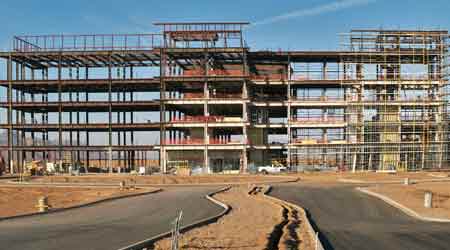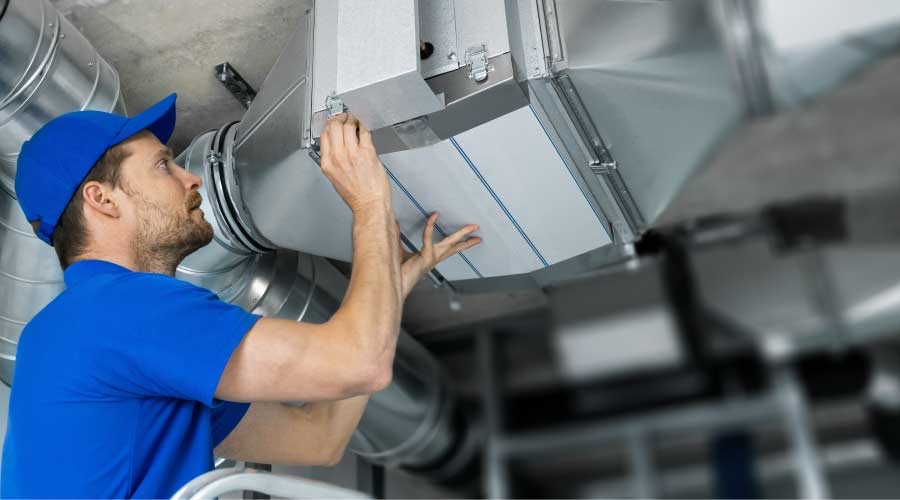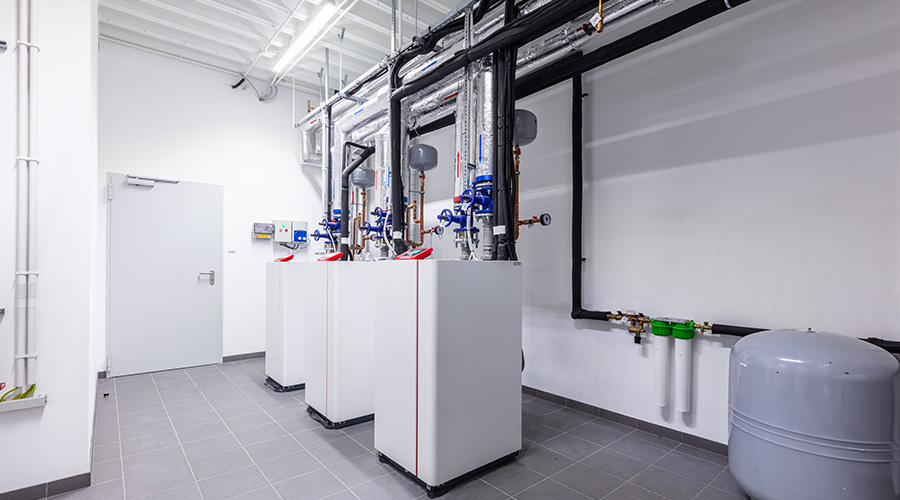 The highest levels of HVAC efficiency are possible only if system design is coordinated with site planning, envelope design, and water system design.
The highest levels of HVAC efficiency are possible only if system design is coordinated with site planning, envelope design, and water system design.LEED and HVAC: How To Balance Costs And Benefits
Understand how HVAC contributes to LEED certification, efficiency, and cost reduction.
There are many reasons that building owners may want to pursue some level of Leadership in Energy and Environmental Design (LEED) certification for a new facility. Certainly they can achieve high levels of sustainability without the LEED label, but the label itself offers value. It can demonstrate to stakeholders, whether students on a campus, citizens in a community, or investors in a company, a commitment to building environmentally sensitive facilities. LEED certification is so highly valued that developers are able to charge more in rents in certain markets when a building is LEED certified.
To obtain LEED certification, building owners and facility staff — as well as designers and builders — have to take steps to mitigate environmental impacts and maximize human comfort during design and construction. But with those benefits come costs. Deciding to attempt LEED certification requires careful planning and investigation of overall costs. Many environmentalists state with assurance that the costs of building a LEED facility are more than offset by the benefits. While there are costs and resulting benefits, some of these benefits are hard to quantify.
LEED certification coalesces building design disciplines: Building architecture, landscape architecture, plumbing, lighting, and HVAC are all major players. At first glance, it is hard to tell where a building owner should invest to glean the highest returns. That is all the more true because different owners will focus on different factors — initial investment, monetary returns, occupant comfort, or environmental impacts. A careful evaluation of the costs and returns will help determine whether and how LEED certification meets the needs of each specific building owner.
The HVAC system has a major impact on any attempt to obtain LEED certification, as would be expected. HVAC consumes a significant portion of a building’s annual energy use. Thus there are significant opportunities for energy savings. HVAC credits fall into two categories: Energy and Atmosphere, which is focused on the building’s energy consumption and release of pollutants, and Indoor Environmental Quality, which is focused on the health and productivity benefits to occupants. An early step in the process of deciding whether to seek LEED certification is to understand the categories, the benefits that LEED aims to achieve, and the potential returns of each.
Each base category establishes one or more prerequisites, which are the minimum requirements to achieve any level of LEED certification. Prerequisites do not earn any LEED points, but the prerequisites have to be achieved to gain LEED certification. For example, in the Energy and Atmosphere category, one prerequisite sets a minimum level of energy efficiency. It establishes a baseline energy performance determined by the type of building and systems; that baseline includes all the energy costs associated with the building, not just those tied to the HVAC system. The goal is to demonstrate, at a minimum, that the building will use less energy annually than a code minimum facility. Over time, these energy reduction targets are increased in an effort to drive the construction of buildings that use less and less energy.
Many factors affect a building’s HVAC energy use. Certainly the choice of equipment and systems plays a major role, but so do building orientation, insulation, shading, etc. Because the architect, instead of the HVAC engineers, often makes these choices, the entire design team has to work together in order to achieve success.
Today, many new and creative technologies will help drive down energy use. For cooling systems, magnetic bearing chillers increase overall system efficiency by reducing friction in the compressor. For heating, condensing boilers capture waste heat that normally leaves the stack and use it for heating. Both systems can achieve less overall energy consumption.
Controls are another step toward HVAC efficiency, as they have the highest ratio of results versus investment. The controls portion includes use of variable frequency drives on chillers, pumps, fans, direct digital controls, water and air-side economizers, demand-controlled ventilation, multi-speed fans, and staged cooling. These technologies help ensure that energy is not used when there is no requirement to do so, or even take wasted heat from one part of the facility to a place it can be used.
The HVAC system is the focus of another Energy and Atmosphere prerequisite: Fundamental Refrigerant Management. The intent of this prerequisite is to reduce ozone depletion. Chlorofluorocarbons were once widely used as refrigerants but were phased out, due to their role in ozone depletion, by the Montreal Protocol, an international treaty. Research on alternatives has been ongoing since the 1970s and these alternatives are now widely available, inexpensive and high performing.
From prerequisites to points
Once the prerequisites are fulfilled, it is time to delve into the points available for energy efficient HVAC design. One key credit in this category is Optimize Energy Performance. As its name implies, this credit seeks to improve energy performance. While the prerequisite required meeting a minimum threshold, this credit rewards buildings that go above and beyond the threshold. The higher the energy cost savings, the more LEED points are awarded.
A building can also achieve high energy performance while limiting the initial cost premium by using clever design techniques such as high-speed centrifugal compressors, variable speed compressors, heat exchangers, highly adept system sizing, evaporative cooling, and heat recovery when working toward additional points. Geothermal systems, whether taking heat from the ground or using the ground as a heat sink, can also lead to significantly lower energy use.
As mentioned earlier, it is important to note that the highest levels of HVAC efficiency are possible only if system design is coordinated with site planning, envelope design, and water system design. Choices most often involve tradeoffs. What may earn more points for energy efficiency may cost points in terms of additional water use.
Although the initial investment in HVAC system efficiency is high, the environmental benefit can have a significant impact on reducing the facility’s annual operating budget each year. This is not as directly measurable with other LEED categories.
Renewable energy and HVAC
Another Energy and Atmosphere credit — On-Site Renewable Energy — encourages the use of on-site renewable energy to reduce the impacts of fossil fuels burning. It evaluates energy produced by renewable energy systems as a percentage of the building’s total energy costs. Photovoltaic and wind power are often employed to assist with this effort.
Note that while sometimes used interchangeably, LEED has not considered “geo-exchange” systems renewable. On-site renewable energy is intended to capture the use of renewable energy sources such as the sun, wind, hydroelectricity, wood chips, etc. Geo-exchange systems are those where near-surface ground is used as a heat source/sink but the system still relies on electric gas heating/cooling to supplement the water that is piped underground. In essence, you are using the ground to reject heat instead of the atmosphere. The good news is that these systems are more energy efficient to operate, and thus earn points for energy reduction. Geothermal systems that do qualify as renewable harness deep-earth water/steam that is used directly to produce power or heat. Additionally, not all biofuel systems qualify as renewable. Known qualifying biofuels include untreated wood waste, animal/organic waste, landfill gas, and agricultural waste. Solid municipal waste does not count.
What’s more, the HVAC system can benefit by receiving thermal and even electric utilities from a district energy plant, in which high-efficiency furnaces/boilers/chillers and other systems are utilized. Plus, district plants often take advantage of technologies such as thermal storage (producing cooling at night for use in the daytime), cogeneration (the simultaneous production of electricity and heat), and the use of renewable inputs for fuels, such as wood chips. Each of these technologies is recognized by the LEED rating system as providing environmental benefits to the buildings they serve, and points are awarded as such. While each of these technologies can be incorporated into the building itself, they can be costly to install and difficult to operate and maintain on a building-by-building basis.
Refrigerant choices
Another HVAC-related credit in this category — Enhanced Refrigerant Management — aims to reduce ozone depletion and support early compliance with the Montreal Protocol. The point under this credit can be earned either by not using refrigerants, or by selecting refrigerants that reduce or eliminate compounds that deplete the ozone. The Montreal Protocol pushed the industry toward developing effective refrigerant alternatives to CFCs. If unable to design the HVAC system without any refrigerants, hydro-fluorocarbon (HFC) based refrigerants are common alternatives with a much lower effect on the ozone layer. However, HFCs were found to negatively impact global warming and in 2016 the Montreal Protocol was amended to begin phasing out this refrigerant.
Currently, there are no refrigerant-free alternatives that do not suffer trade-offs in terms of cost, efficiency, or safety. Common refrigerant-free alternatives include absorption refrigerating systems (high initial cost, low efficiency, toxicity if ammonia-based, difficult to maintain), chilled water/glycol systems (high energy demand for pumping, additional costs), carbon dioxide systems (high initial cost, safety, and maintenance concerns due to high working pressures), and evaporative cooling systems (no heating ability, not as effective in humid environments). While no clearly favorable alternative exists at the moment, the industry is investing a lot of money into research and development in search of one.
There are many choices the building owner and design team have to make on the path to LEED certification. Some of these choices have a direct and easily measurable impact on a building’s annual operating budget and can, as a result, provide a measurable ROI. The choices made in how to best heat, cool, and ventilate a building certainly fall into that category.
April Ruggles, EIT, is a mechanical engineer at RMF Engineering, a full-service engineering firm that has more than 30 LEED certified professionals on staff and more than 100 projects that have achieved or are striving for LEED certification. Ruggles can be reached at april.ruggles@rmf.com.
Email comments and questions to edward.sullivan@tradepress.com.
Related Topics:












